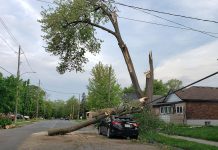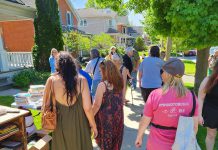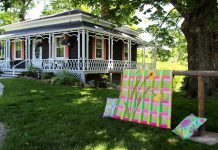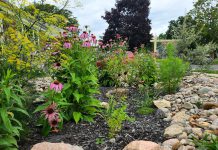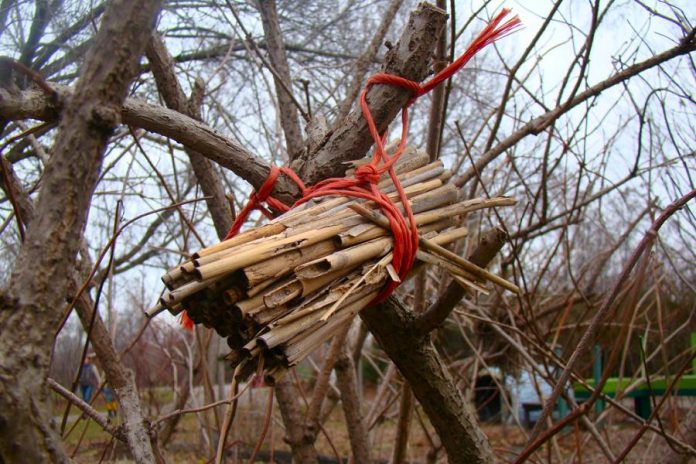
Over the past few years, more people are transforming their yards from lawn to a more wildlife-friendly landscape, which provides a healthier habitat for many species including wild bees.
Did you know that wild bees pollinate most of our backyard fruits, berries, and vegetables? Acccording to the Xerces Society, the ecological service native bees provide is necessary for the reproduction of over 85% of the world’s flowering plants — including more than two-thirds of the world’s crop species.
In 2011, over 350 species of bees were documented in the Greater Toronto Area. It was estimated that an average yard in the GTA hosted 50 bee species actively nesting or foraging. Wild bees are mostly solitary in nature and, like honeybees, they struggle to maintain their populations due to urbanization, pollution, invasive species, habitat loss, and disease.
Approximately 70% of Ontario’s wild bees nest in the ground in hidden spots such as underneath cracks in the sidewalk, in rotting logs, or in gravel and sandy areas. Some of our city’s worn footpaths and bare roadsides have created suitable nesting sites for ground nesting, wild bees who seek a certain type of soil and compaction for laying eggs. Wild bees appreciate you leaving a few bare patches of ground in your garden, so they can create a nesting site close to their foraging source.
Approximately 30% of Ontario’s wild bees are cavity dwellers meaning that solitary, female bees must find narrow, hollow crevices to lay their eggs in single rows. Eggs are placed within a pollen ball containing pollen and nectar and are usually round or oval in shape. Depending on the type of bee, the eggs are segmented from one other with mud mixtures, waterproofing plant cellulose, or leaf material collected by nearby plants.
Females lay an egg, close the cell, and repeat the process until the hollow cavity is full. It takes several weeks for the eggs to hatch. The larvae then consume the pollen and nectar ball, and then each larvae metamorphoses into an adult bee.
Bees are very industrious insects and will search high and low for the right nest site to raise their young. In urban settings, bees sometimes consider additional nest sites, such as at the base of fire hydrants, in strategically placed drinking straws, and in tunnels burrowed into decks. While these nest sites are sometimes a bit of an inconvenience for us, they are crucial to allow females to raise the next generation of pollinators.
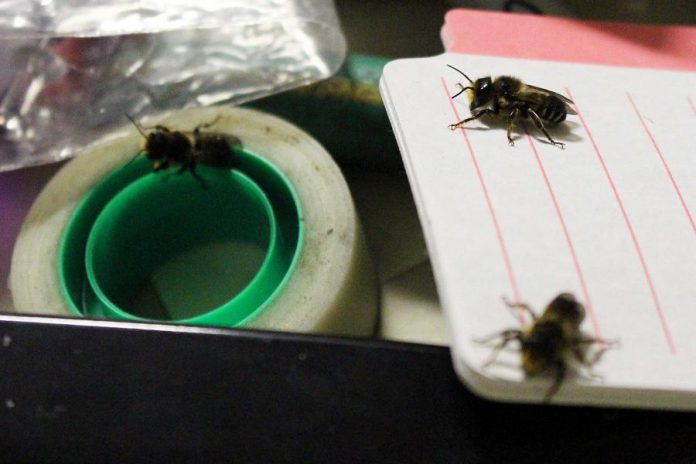
Last summer at the GreenUP office, one of our staff members had a big surprise when she opened her desk drawer. Inside, several leafcutter bees were crawling around.
How did they get there? After the leafcutter bees were safely moved outside, we discovered a hollow section of garden hose inside the drawer — it had been used the season before as a tree guard. Before it was removed from the tree and brought into the office, a female leafcutter bee thought this hose was an ideal nesting site and had laid her eggs within it!
Making a simple bee house is a wonderful way to observe these remarkable pollinators in your yard (instead of inside your home or office). Depending on the time of year, season, and even the time of day, your bee house will be frequented by a variety of bees making it easy to closely study their unique characteristics.
Wild bee houses can be made with natural hollow, straw-like materials of varying diameters (ranging from 3mm to 10mm) and lengths (ranging from 10cm to 30cm). Simply bundle them tightly together and secure them in a nook of a tree branch or a shrub.
Some bee houses are similar in size and shape to a small birdhouse and contain removable reeds, cardboard and paper tube inserts, bamboo rods, or twigs.
Wild bee houses can also be made from untreated, solid wood logs or blocks drilled with varying diameter holes for bee nesting.
Unlike honeybees that regenerate their population throughout the season, only a few wild bees in our region live for more than one generation per year and species are rarely seen for more than a one-month period. The majority of our wild, solitary bees spend the winter as fully-grown larvae within the nesting cavity, emerging once per year in sync with the timing of the flowers they provide pollination services for.
This time of year, many wild bees (including bumblebees) are in a state called diapause, which is a type of hibernation that lasts until the weather warms up. This is a perfect time to make some bee houses and have them prepared to install early April.
GreenUP and The Endeavour Centre are hosting a workshop, “Build Your Own Bee Hotel”, on Saturday, April 22nd. In this workshop, participants will receive hands on instruction building a bee house, with a few designs to select from.
Participants will also learn more about Peterborough’s wild bees and pollinator-friendly plants, and will be introduced to GreenUP’s new Native Bee Share citizen science program, which will monitor cavity nesting bee numbers, nesting patterns, and pests and diseases, while stewarding and restoring pollinator habitat.
For more information about the Build Your Own Bee Hotel workshop and the GreenUP Native Bee Share program, visit greenup.on.ca.
For more information and resources about pollinator conservation and wild bees in our region visit The Xerces Society for Invertebrate Conservation, The City of Toronto Biodiversity Booklet Series, Feed The Bees, and the Farms at Work Native Bee Resources.
All photos courtesy of GreenUP. Note: The “Build Your Own Bee Hotel” workshop originally scheduled for Sunday, April 16th now takes place on Saturday, April 22nd.




